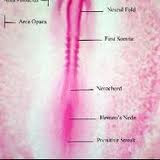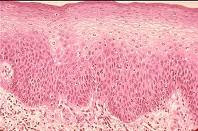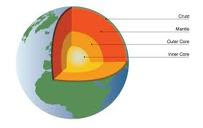
2. adipose tissue: A connective tissue having an abundance of fat-storing cells.

3. blood Fluid: connective tissue of water, solutes, and formed elements (blood cells, platelets). Transports substances to and from cells, helps maintain internal environment.

4. bone tissue Of vertebrate skeleton: a tissue of osteoblast secretions hardened with minerals.

5. cardiac muscle tissue: A contractile tissue that is present only in the heart wall.

6. cartilage: Connective tissue with solid, pliable intercellular material that resists compression.

7. dense, irregular connective tissue: Animal tissue with fibroblasts, many asymmetrically positioned fibers in ground substance. In skin and some capsules around organs.

8. dense, regular connective tissue: Animal tissue with rows of fibroblasts between parallel bundles of fibers. In tendons, elastic ligaments.

9. ectoderm The first-formed: outermost primary tissue layer of animal embryos; gives rise to nervous system tissues and integument's outer layer.

10. endocrine gland: Ductless gland that secretes hormones, which the bloodstream distributes.

11. endoderm: Inner primary tissue layer of animal embryos; source of inner gut lining and derived organs.

12. epithelium: Animal tissue that covers external surfaces and lines internal cavities and tubes. One surface is free and the other rests on a basement membrane.

13. exocrine gland: Glandular structure that secretes products, usually through ducts or tubes, to a free epithelial surface.

14. gap junction: Cylindrical arrays of proteins in the plasma membrane that pair up as open channels for signals between adjoining cells.

15. gland cell: A cell that secretes products unrelated to their own metabolism for use elsewhere

16. homeostasis: State in which physical and chemical aspects of internal environment (blood, interstitial fluid) are being maintained within ranges suitable for cell activities.

17. internal environment: Blood + interstitial fluid.

18. loose connective tissue: Animal tissue with fibers, fibroblasts loosely arrayed in semifluid ground substance.

19. mesoderm: Primary tissue layer of all large, complex animals; gives rise to many internal organs.

20. nervous tissue: Connective tissue composed of neurons and often neuroglia.

21. neuroglia: Collectively, cells that structurally and metabolically support neurons. They make up about half the volume of nervous tissue in vertebrates.

22. neuron: Type of nerve cell; basic communication unit in most nervous systems.

23. organ: Body structure with definite form and function that consists of more than one tissue.

24. organ system: Organs interacting chemically, physically, or both in a common task.

25. skeletal muscle tissue: Striated contractile tissue that is the functional partner of bone.

26. smooth muscle tissue: Nonstriated contractile tissue found in soft internal organs.

27. tight junction: Cell junction where strands of fibrous proteins oriented in parallel with a tissue's free surface collectively block leaks between the adjoining cells.

28. tissue Of multicelled organisms: a group of cells and intercellular substances that function together in one or more specialized tasks.
























